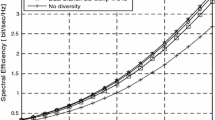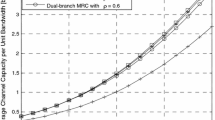Abstract
System performances of dual selection combining over fading channels are analyzed. Fading between the diversity branches and between interferences is correlated and Rician distributed. Infinite series expressions for the probability density function, and the cumulative distribution function of the output signal-to-interference ratio are derived, which is the main contribution of this paper. Outage probability and the average bit error probability for noncoherent modulation schemes are also presented. Numerical results, presented in this paper, point out the effects of fading severity and correlation on the system performances.
Similar content being viewed by others
References
Stuber G. (2000) Principles of mobile communication. Kluwer, Boston
Lee, W. C. Y. (1992). Mobile communications engineering. New York: Mc-Graw-Hill. 0-7803-7005-8/01, IEEE, 1992.
Simon M. K., Alouini M.-S. (2000) Digital communication over fading channels. Wiley, New York
Neasmith E. A., Beaulieu N. C. (1998) New results in selection diversity. IEEE Transactions Communications 46: 695–704
Okui S. (2000) Effects of SIR selection diversity with two correlated branches in the m-fading channel. IEEE Transactions Communications 48: 1631–1633
Austin, M. D., & Stuber, G. L. (1995). In-service signal quality estimation for TDMA cellular systems. In Sixth IEEE international symposium on personal, indoor and mobile radio communications (pp. 836–840) PIMRC ‘95 Toronto, ON, Canada.
Brandao A. L., Lopez L. B., McLernon D. C. (1994) Co-channel interference estimation for M-ary PSK modulated signals. IEEE Wireless Personal Communications 1(1): 23–32
Witrisal K., Kim Y. H., Prasad R. (2001) A new method to measure parameters of frequency-selective radio channels using power measurements. IEEE Transactions Communications 49: 1788–1800
Corazza G. E., Vatalaro F. (1994) A statistical model for land mobile satellite channels and its application to no geostationary orbit systems. IEEE Transactions on Vehicular Technology 43(3): 738–742
Wakana, H. (1991). A propagation model for land mobile satellite communications. In Proceedings of IEEE antennas and propagation society international symposium (vol. 3, pp. 1526–1529), London, ON, Canada.
Stefanović, M., et al. (2007). Performance analysis of system with selection combining over correlated Weibull fading channels in the presence of cochannel interference. International Journal of Electronics and Communications (AEU), doi:10.1016/j.aeue.2007.09.006.
Sagias N. C., Karagiannidis G. K., Zogas D. A., Mathiopoulos P. T., Tombras G. S. (2004) Performance analysis of dual selection diversity over correlated Weibull fading channels. IEEE Transactions Communications 52(7): 1063–1067
Sagias N. C., Zogas D. A., Karagiannidis G. K. (2005) Selection diversity receivers over no identical Weibull fading channels. IEEE Transactions on Vehicular Technology 54(6): 2146–2151
Mallik R. K. (2003) On multivariate Rayleigh and exponential distributions. IEEE Transactions on Informaton Theory 49: 1499–1515
Karagiannidis G. K., Zogas D. A., Kotsopoulos S. A. (2003) On the multivariate Nakagami-m distribution with exponential correlation. IEEE Transactions Communications COM-51: 1240–1244
Reig, J. (2007). Multivariate Nakagami-mdistribution with constant correlation model. International Journal of Electronics and Communications (AEU), doi:10.1016/j.aeue.2007.10.009.
Bithas, P. S., & Mathiopoulos, P. T. (2007). Performance analysis of SSC diversity receivers over correlated Rician fading satellite channels. EURASIP Journal on Wireless Communications and Networking, 2007, Article ID 25361.
Bandjur D. V., Stefanovic M. C., Bandjur M. V. (2008) Performance analysis of SSC diversity receivers over correlated Rician fading channels in the presence of co-channel interference. Electronic letters 44(9): 587–588
Karagiannidis G. K. (2003) Performance analysis of SIR-based dual selection diversity over correlated Nakagami-m fading channels. IEEE Transactions on Vehicular Technology 52: 1207–1216
Gradshteyn I., Ryzhik I. (1980) Tables of integrals, series, and products. Academic Press, New York
Author information
Authors and Affiliations
Corresponding author
Rights and permissions
About this article
Cite this article
Mosić, A.V., Stefanović, M.Č., Panić, S.R. et al. Performance Analysis of Dual-Branch Selection Combining Over Correlated Rician Fading Channels for Desired Signal and Cochannel Interference. Wireless Pers Commun 55, 475–484 (2010). https://doi.org/10.1007/s11277-009-9810-4
Received:
Accepted:
Published:
Issue Date:
DOI: https://doi.org/10.1007/s11277-009-9810-4




